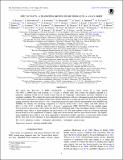EPIC 201702477b: A TRANSITING BROWN DWARF FROM K2 IN A 41 DAY ORBIT
Author(s)
Dragomir, Diana
DownloadBayliss-2017-EPIC 201702477b_ A TRANSITING BRO.pdf (765.0Kb)
PUBLISHER_POLICY
Publisher Policy
Article is made available in accordance with the publisher's policy and may be subject to US copyright law. Please refer to the publisher's site for terms of use.
Terms of use
Metadata
Show full item recordAbstract
We report the discovery of EPIC 201702477b, a transiting brown dwarf in a long period (40.73691 ± 0.00037 day) and eccentric (e = 0.2281 ± 0.0026) orbit. This system was initially reported as a planetary candidate based on two transit events seen in K2 Campaign 1 photometry and later validated as an exoplanet candidate. We confirm the transit and refine the ephemeris with two subsequent ground-based detections of the transit using the Las Cumbres Observatory Global Telescope 1 m telescope network. We rule out any transit timing variations above the level of ~30 s. Using high precision radial velocity measurements from HARPS and SOPHIE we identify the transiting companion as a brown dwarf with a mass, radius, and bulk density of 66.9 ± 1.7 MJ, 0.757 ± 0.065 RJ, and 191 ± 51 g cm[superscript −3] respectively. EPIC 201702477b is the smallest radius brown dwarf yet discovered, with a mass just below the H-burning limit. It has the highest density of any planet, substellar mass object, or main-sequence star discovered so far. We find evidence in the set of known transiting brown dwarfs for two populations of objects—high mass brown dwarfs and low mass brown dwarfs. The higher-mass population have radii in very close agreement to theoretical models, and show a lower-mass limit around 60 MJ. This may be the signature of mass-dependent ejection of systems during the formation process.
Date issued
2016-12Department
MIT Kavli Institute for Astrophysics and Space ResearchJournal
The Astronomical Journal
Publisher
IOP Publishing
Citation
Bayliss, D. et al. “EPIC 201702477b: A TRANSITING BROWN DWARF FROM K2 IN A 41 DAY ORBIT.” The Astronomical Journal 153.1 (2016): 15. © 2016 The American Astronomical Society
Version: Final published version
ISSN
1538-3881
0004-6256